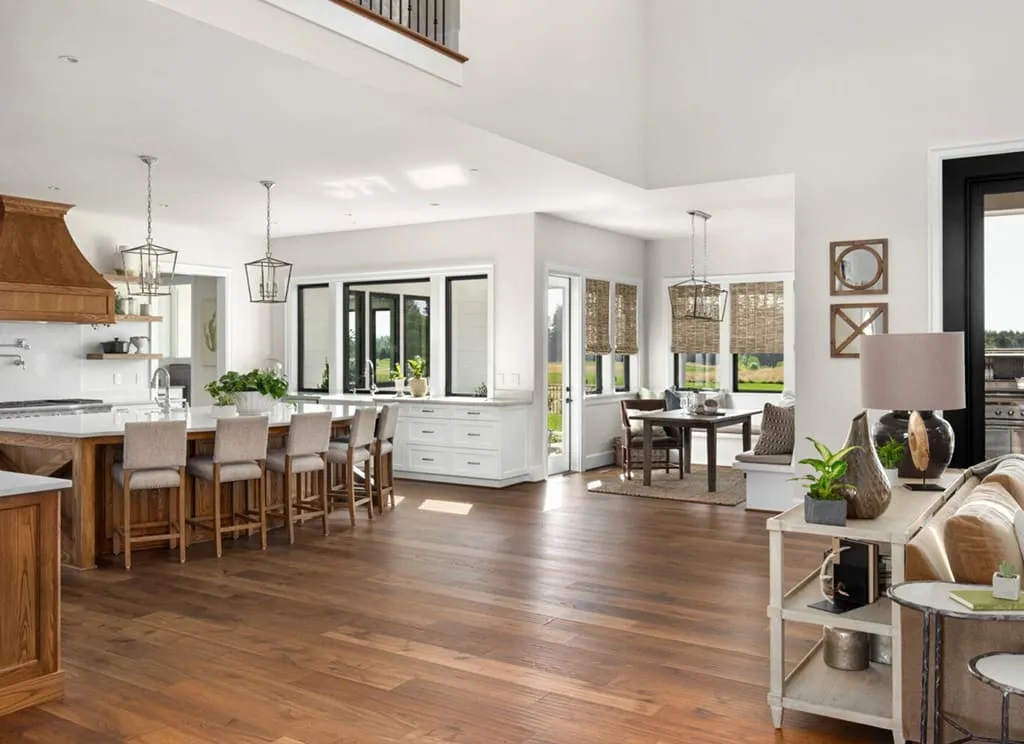Blending old and new is like mixing a cocktail—you want just the right balance of ingredients for that perfect flavor. The same goes for interior design. One of the hottest trends today is combining sleek, modern interiors with the timeless charm of vintage flooring. Sounds tricky? It doesn’t have to be. Let’s dive into how you can master the art of merging generations in your living space.
Understanding the Basics
What Defines Vintage Flooring?
Vintage flooring isn’t just “old.” It’s character-rich, storied, and often made with materials and craftsmanship that are hard to find today. Think herringbone parquet, wide-plank oak, or black-and-white checkerboard tiles. These floors have history—and they wear it proudly.
Characteristics of Modern Interiors
Modern interiors favor simplicity. Clean lines, neutral color palettes, minimalist furniture, and open-concept layouts dominate today’s spaces. The goal? Let the space breathe. It’s not about showing off every piece—it’s about intentional design.
Why Blend Vintage with Modern?
Creating Contrast and Balance
Picture this: a stark white modern kitchen with sleek cabinetry… and beneath your feet, rich, warm reclaimed wood floors. That contrast? Pure magic. The old grounds the new, and the new elevates the old.
Emotional and Aesthetic Appeal
Vintage flooring tells a story. Pairing it with modern interiors creates a living space that feels curated, intentional, and deeply personal—like an art gallery with layers of time baked into every corner.
Choosing the Right Vintage Flooring
Popular Types: Parquet, Reclaimed Wood, Checkerboard Tiles
Not all vintage floors are created equal. Choosing the right type for your space depends on the look you’re going for, the room’s function, and even your home’s age.
Matching Vintage Flooring with Your Home’s Character
If your home is a mid-century gem, leaning into parquet might feel organic. Living in a modern build? Reclaimed wood can add soul. Don’t fight the architecture—work with it.
Parquet Flooring
Once reserved for palaces and luxury homes, parquet is making a big comeback. Its geometric patterns—like herringbone or chevron—add movement and texture. And guess what? It plays beautifully with minimalist modern furniture.
Reclaimed Wood Floors
Sustainability meets sophistication. Reclaimed wood isn’t just eco-friendly; it’s full of knots, nail holes, and quirks that make every plank unique. Want a modern twist? Try pairing it with matte black fixtures and open shelving.
Tips for Restoration and Preservation
- Avoid sanding too often—less is more.
- Use oil-based finishes for a natural sheen.
- Keep humidity in check to avoid warping.
Classic Checkerboard Tiles
Retro? Sure. But also timeless. Black-and-white checkerboard tiles are bold and elegant, making them perfect for kitchens, bathrooms, and even entryways. Match them with white walls and metallic accents for a chic, Parisian feel.
Key Modern Design Elements to Incorporate
Minimalist Furniture
Simple silhouettes let your vintage flooring shine. Think clean-lined sofas, open-leg chairs, and floating shelves.
Neutral Color Palettes
Modern interiors love whites, beiges, and grays. These tones form a neutral canvas that allows the rich hues of vintage flooring to pop.
Clean Lines and Open Spaces
Avoid clutter. Open space gives vintage flooring the spotlight it deserves.
Design Tips for a Harmonious Blend
Use of Textures and Layering
Layer soft rugs over hard floors. Mix metals with woods. Combine glass with fabric. This tactile approach makes your space feel alive.
Contrast Without Clashing
Contrast is good—chaos is not. If your hardwood flooring is dark and dramatic, balance it with light walls and simple furniture.
Strategic Lighting Choices
Warm lighting flatters vintage tones. Use pendant lights or floor lamps to cast soft glows on your floors, highlighting their age and charm.
Accent Pieces that Bridge the Gap
Mid-Century Modern Furniture
It’s the sweet spot between old and new. Its curves and wood tones complement vintage floors without feeling dated.
Industrial Elements
Metal fixtures, exposed beams, or raw concrete details introduce modern edge to vintage warmth.
Artisan Accessories
Handmade pottery, woven baskets, and textured throws add personality and softness.
Wall Treatments that Compliment Vintage Floors
Statement Walls
Think shiplap, brick veneer, or bold paint colors that ground your space.
Neutral Paints vs. Bold Wallpapers
Go neutral to keep the focus on the floor—or go bold with wallpaper for a stunning contrast.
Creating Visual Flow Across Rooms
Consistent Design Language
Carry common colors or materials throughout the home. A reclaimed oak floor in the living room should feel like a cousin to the ceramic tile in the kitchen.
Transition Spaces: Thresholds, Rugs, and Tiles
Use area rugs, inlays, or thresholds to transition from one room to another while preserving continuity.
Common Mistakes to Avoid
Overdesigning
Let the floor breathe. Don’t throw in every trend you love—less really is more here.
Ignoring Floor Tone and Grain
Wood has undertones—some warm, some cool. Know yours and match surrounding elements accordingly.
Mismatched Eras
Stick to a cohesive vision. A Victorian floor may not vibe with ultra-futuristic decor. Stay in your lane.
Real-Life Inspirations
Case Studies from Designer Homes
Designers like Joanna Gaines and Nate Berkus have mastered the mix. Think open-concept spaces with shiplap walls and vintage floors that whisper history.
Before-and-After Transformations
Before: Cold, sterile rooms.
After: Warm, inviting spaces full of depth and contrast—all thanks to that vintage flooring.
Maintenance and Care Tips
- Use felt pads under furniture to avoid scratching.
- Clean with pH-neutral cleaners.
- Avoid soaking wood floors—dry mopping is your best friend.
Conclusion
Blending modern interiors with vintage flooring isn’t just a design trend—it’s a love letter to the past written in a modern hand. It brings soul, warmth, and authenticity to your space. So go ahead—let your floors tell their story, and design the future around them.
FAQs
- How do I prevent my vintage floors from clashing with modern decor?
Stick to a consistent color palette and use transitional pieces like mid-century furniture or neutral rugs to bridge the gap. - Are vintage floors suitable for small apartments?
Absolutely. Vintage flooring can add character to small spaces—just keep the rest of the decor light and minimal to avoid visual clutter. - Can I install underfloor heating with old wooden floors?
Yes, but consult a pro. Not all vintage woods handle heat well. Engineered wood is often a safer bet. - What rugs pair well with vintage flooring?
Go for natural fibers like jute or wool in muted tones to complement, not compete with, the floor’s texture. - How do I know if my vintage floor is worth restoring?
Check for deep damage, rot, or warping. If the structure’s sound, it’s probably worth giving it a second life.
Source url – https://sites.google.com/view/firstclassflooring/design-tips-blending-modern-interiors-with-vintage-flooring
- Design Tips: Blending Modern Interiors with Vintage Flooring
- Blending modern interiors with vintage flooring isn’t just a design trend—it’s a love letter to the past written in a modern hand.
- Vintage flooring, hardwood flooring
Related posts:
 Can Residential End of Lease Cleaning Help You Get Your Bond Back?
Can Residential End of Lease Cleaning Help You Get Your Bond Back?
 How Much Do Gutter Services Cost in Bradford in 2025 | Complete Price Guide
How Much Do Gutter Services Cost in Bradford in 2025 | Complete Price Guide
 Top-Rated Swimming Pool Remodeling in Hoover AL You Can Trust
Top-Rated Swimming Pool Remodeling in Hoover AL You Can Trust
 Comprehensive Guide to Services Offered by Professional Landscapers in Durham
Comprehensive Guide to Services Offered by Professional Landscapers in Durham
 Why Pet Owners Prefer WPC Decking for Safe, Durable Backyards
Why Pet Owners Prefer WPC Decking for Safe, Durable Backyards
 24/7 Emergency Plumber Near You – Fast, Reliable & Affordable!
24/7 Emergency Plumber Near You – Fast, Reliable & Affordable!
 Take Action Now to Ensure Complete Workplace OHS Safety Compliance
Take Action Now to Ensure Complete Workplace OHS Safety Compliance
 Small Bedroom Design/Small Bedroom Tips That Make a Big Impact
Small Bedroom Design/Small Bedroom Tips That Make a Big Impact








